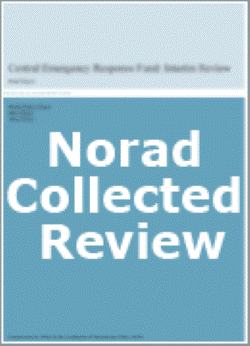Mid-term Review of Inter-Sectoral response to HIV/AIDS in Angola
Om publikasjonen
- Utgitt: januar 2009
- Serie: Norad-innsamlede rapporter
- Type: --
- Utført av: Pamela Rebelo (NCG) and Svein Jørgensen (NCG)
- Bestilt av: Royal Norwegian Embassy in Luanda, Angola
- Land:
- Tema: Hiv/aids
- Antall sider: 78
- Serienummer: 28/2008
- ISBN: 978-82-7548-356-8
- ISSN: --
- Prosjektnummer: AGO-05/019

The Project
Sweden and Norway entered into an agreement of nearly USD 8 million with UNICEF on Inter-sectoral response to HIV/AIDS in Angola (IRHA-programme). The goal of the 2006-2008 programme is "to improve the survival, safety health and social acceptance of children and youth directly or indirectly affected by HIV/AIDS, with a particular focus on girls and young women". The purpose is "to enhance institutional capacity to ensure rapid, multi-sectoral and decentralised responses to the epidemic; reduce the incidence of Sexually Transmitted Infections (STI) and HIV/AIDS, and to mitigate the impact of HIV/AIDS on individuals, families and communities". The programme has concentrated on a number of projects in Cunene Province for promoting synergies and lessons learnt. The Norwegian commitment for 2006-2008 is NOK 20 mill. Sweden has committed SEK 35 mill for the same period.
Interesting Findings
The programme as a whole has made a significant contribution to fighting HIV/AIDS in Angola. It successfully matches the country's needs as presented in the government's Strategic Plan (2007-2010) with UNICEF's mandate, in particular through its decision to focus on youth-oriented prevention.
Achievements of the purpose and goal:
• Building institutional capacity; yes, through support for the local health authority in Cunene, through its ongoing work with INLS (National Institute for the Fight of HIV/AIDS) and contributions to national guidelines, - its work with ministries with mass campaigns and school-based programmes and the communication strategy that could have some important institutional and public education implications.
• Reducing the incidence of HIV/AIDS; yes, there is a strong probability of impact of the most seriously affected Cunene province through the concentration of mutually reinforcing projects.
• Mitigating socio-economic impact: Not through the single pilot initiative although other activities aspects of the programme such as the clinical / outreach and paediatric AIDS support must also have helped.
• Improved survival, safety, health, and social acceptance of HIV/AIDS affected: As regards "survival safety and health" probably good impact in the provinces where the programme has a geographical focus with mutually reinforcing components, as in the case of Cunene. "Social acceptance" is more complex as it requires a long slow haul rather than a quick fix. Nevertheless, the programme provided strong "kick-off" support with its youth-directed saturation campaigns, life skills clubs as well as support for People Living With Aids (PLWA).
As regards the planned and real balance of the components (in bullets above), the IHRA seems to give much more weight to clinical and outreach services than the more difficult technical and institutional capacity building - and the latter should have had greater priority according to the team to ensure sustainability.
The programme's weakest points are its monitoring and reporting shortcomings. Each of the 20 or so projects/activities had indicators (without targets) and narrative reporting obligations and had defined and listed various monitoring tools (reports, sentinel sites, youth Knowledge, Attitudes, Behaviour and Practices (KABP) surveys etc) but without any indication as to which would be used where and for what purpose.
